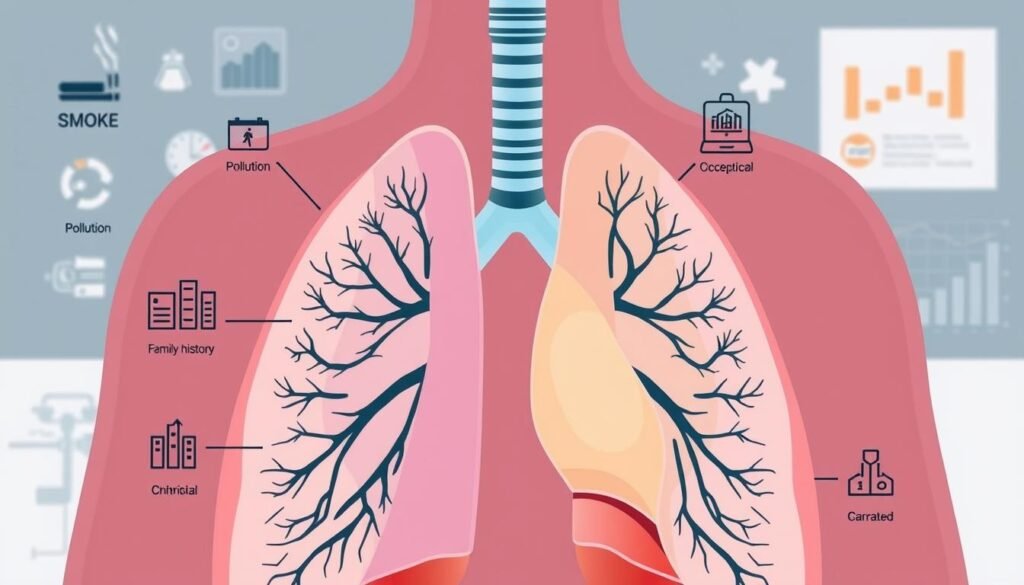Did you know the survival rate for stage 4 non-small cell lung cancer is only 8 percent? This shocking fact shows how hard it is for those with stage 4 lung cancer and a collapsed lung. As cancer moves to distant organs, treatments are harder and work less well. It’s vital for patients and caregivers to understand this complex situation. It highlights the need for thorough lung cancer treatment and kind care.
This guide offers insights on stage 4 lung cancer, especially with a collapsed lung. It talks about symptoms, diagnostic processes, causes and risks, and treatment options. We also cover palliative care and support resources. Our goal is to help you understand this tough diagnosis. We aim to show the importance of caring for both the body and the heart during this time.
Key Takeaways
- Stage 4 lung cancer has a five-year relative survival rate of only 8% for non-small cell types.
- Metastatic lung cancer complicates treatment options significantly.
- Comprehensive care, including symptom management and emotional support, is vital.
- Palliative care focuses on enhancing quality of life rather than prolonging it.
- Awareness of symptoms and prompt medical attention can impact treatment outcomes.
- Support resources are available to help patients and caregivers navigate this journey.
Understanding Stage 4 Lung Cancer
Stage 4 lung cancer is the most serious form of the disease. It means the cancer has spread to other parts of the body, known as metastatic lung cancer. At this stage, treatment mostly focuses on making the patient comfortable. The goal is to relieve symptoms and improve life quality.
People with stage 4 lung cancer often face tough symptoms. These can include fluid around the lungs and blocked airways. Brain metastases may cause headaches or seizures. Also, chronic cough, breathlessness, fatigue, losing a lot of weight, and pain are usual as the cancer spreads.
As the disease advances, extreme fatigue and weight loss become more common. This is often with muscle wasting. Palliative treatments help ease discomfort. They use radiation therapy and medications for pain relief. These methods are important for comfort and life quality.
Emotional and spiritual changes also happen for those with advanced lung cancer. Many patients might pull away socially. They often think about their life’s end. Knowing what to expect helps families and caregivers support their loved one. Recognizing signs that the end is near is crucial. This includes less appetite, changing breathing patterns, and confusion.
The five-year survival rate for advanced lung cancer is about 8 percent. This data comes from the National Cancer Institute’s SEER Program. It shows how serious stage 4 lung cancer is. Families use this information to make tough decisions on this hard journey.
Lung Cancer Symptoms to Watch For
Lung cancer can grow without causing noticeable lung cancer symptoms. This makes early detection hard but very important. Catching the disease early can lead to better treatment outcomes.
Watch out for these common symptoms:
- Persistent cough
- Coughing up blood (hemoptysis)
- Chest pain
- Shortness of breath
- Hoarseness
- Loss of appetite
- Weight loss
- Fatigue
- Recurring infections
As the disease reaches its final stage, more symptoms may appear. This happens as the cancer spreads.
- Bone pain
- Changes in the nervous system
- Jaundice
- Swelling in lymph nodes
- Conditions like Horner syndrome
Small cell lung cancer can lead to paraneoplastic syndromes. These affect the nervous and endocrine systems. Symptoms can include:
- Muscle cramps and weakness
- Elevation of calcium levels in the blood
- Clubbing of fingertips
Knowing these lung cancer symptoms helps in coping with the disease. It’s crucial to recognize these signs early. Early recognition can improve the chances of effective treatment and care.
| Common Symptoms | Symptoms of Spread | Paraneoplastic Syndromes |
|---|---|---|
|
|
|
Diagnosing Stage 4 Lung Cancer with Collapsed Lung
When diagnosing lung cancer, doctors use several tests. These tests can spot lung problems early. Chest x-rays are often the first step. They look for odd things in the lungs. If they find something, CT scans are next. They’re really good at spotting lung tumors.
Stage 4 lung cancer can sometimes cause a collapsed lung. This is known as pneumothorax. The reasons for a collapsed lung are many. Doctors need to check thoroughly to see how it relates to the cancer. If the cancer has spread, MRI scans are used. They check critical areas like the brain, spinal cord, or liver. Then, PET scans give a detailed picture. They work with CT scans to figure out the stage and spread of cancer.
If doctors think the cancer has spread to the bones, bone scans help. Getting tissue samples is key. They use fine needle aspiration (FNA) and core needle biopsy (CNB) to get these samples. Core biopsies are better because they give more tissue. This helps diagnose accurately.
To look at blockages or tumors inside the airways, bronchoscopy is helpful. It lets doctors see and maybe biopsy suspicious spots. Mediastinoscopy and mediastinotomy are for checking lymph nodes. They help understand if cancer has spread there.
Thoracoscopy checks if cancer has reached between the lungs and chest wall. It’s not very common. Knowing all these methods is crucial. It helps decide on the best treatment. Being informed helps patients and caregivers push for the tests they need.
Stage 4 Lung Cancer with Collapsed Lung: Causes and Risks
Lung cancer comes from many sources. Both inborn traits and external factors can trigger it. Smoking is the biggest cause, linked to about 85% of lung cancer cases. Things like air pollution and secondhand smoke are also big risks. Family history and certain gene changes can make lung cancer more likely too.
Studies show a strong connection between lung cancer and past lung issues. People with chronic lung diseases such as COPD or pulmonary fibrosis face higher cancer risks. In a study of over 5,500 lung cancer patients, a small number had pneumothorax. This can be a severe problem and sometimes the first clue of lung cancer.
A table detailing the types of lung cancer associated with pneumothorax illustrates the variations present in patients diagnosed:
| Type of Lung Cancer | Number of Patients |
|---|---|
| Adenocarcinoma | 8 |
| Epidermoid Carcinoma | 7 |
| Alveolar Cell Carcinoma | 3 |
Pneumothorax in patients has various causes. Tissue necrosis and bleb ruptures are common reasons. So is air trapping caused by tumors blocking airways. Radiation and chemotherapy can up the risks too.

Knowing about lung cancer causes and risks helps spot those in danger. Early detection of symptoms can lead to better survival rates. It’s key to understand both environmental and genetic factors for lung cancer management.
Treatment Options for Stage 4 Lung Cancer
The treatment landscape for stage 4 lung cancer includes several strategies tailored to each patient. Chemotherapy and targeted therapy play key roles. In some cases, surgery might be an option if the cancer hasn’t spread too far. Knowing these options is vital for effective disease management.
Surgery
For some stage 4 lung cancer patients, surgery is a possible treatment route. It may involve removing tumors from the lung, adrenal gland, or brain. Whether surgery is an option depends on the tumor’s spread and the medical team’s assessment.
Chemotherapy and Targeted Therapy
Chemotherapy is often used to treat non-small cell lung cancer. Common drugs include cisplatin or carboplatin with gemcitabine. Targeted therapy offers a promising alternative for certain genetic mutations. Drugs like crizotinib (Xalkori) and sotorasib (Lumakras) attack specific cancer cell markers, benefiting patients with ALK or KRAS mutations.
EGFR-positive lung cancer patients may benefit from treatments like erlotinib (Tarceva) or osimertinib (Tagrisso). Immunotherapy drugs such as pembrolizumab (Keytruda) and atezolizumab (Tecentriq) are also effective for certain cases. These therapies focus on controlling the cancer’s progression and managing symptoms.
Palliative Care for Advanced Lung Cancer
Palliative care improves the quality of life for those with advanced lung cancer. It doesn’t cure the disease. Instead, it eases symptoms and offers emotional support. Professionals like doctors and nurses work together. They focus on managing symptoms for patients facing tough health issues.
Patients may face pain, breathing issues, and fatigue during lung cancer treatment. They might also feel anxious or depressed. Palliative care helps reduce these symptoms. It includes various supportive options. Patients might get treatments to help them breathe, pain relief, and nutritional support. They may also try integrative therapies like massage.
Palliative care is available in different places. It can be accessed in hospitals, outpatient clinics, and at home. Procedures like thoracentesis help remove fluid around the lungs. This improves breathing. Other strategies manage tumors that block airways.
Early palliative care might help patients with certain lung cancers live longer. It improves the quality of life and health. This care also involves discussing end-of-life options. It helps patients and families talk about their fears and hopes.
Caregivers also get support through palliative care. They face their challenges while caring for someone with cancer. It’s important they get the help they need. This ensures the well-being of both caregivers and patients.
Learn more about lung cancer and palliative care at this useful resource.

Managing a Collapsed Lung in Lung Cancer Patients
A collapsed lung, or pneumothorax, is tough for people with lung cancer. It causes shortness of breath and chest pain, making lung cancer worse. Knowing how to manage this is key for those affected.
There are ways to fix a collapsed lung. These include putting in chest tubes or having surgery, depending on how bad it is. It’s important to know when to get help fast to fix these problems.
Lung cancer can bring more issues, like blocked airways and fluid in the lungs. These make breathing hard and lower life quality. Tools like bronchoscopy can help make breathing easier by dealing with these issues.
Choosing a healthy way of life helps manage these troubles. Not smoking, drinking enough water, and doing breathing exercises help a lot. Eating well and getting enough sleep also boost lung function and overall health.
A pleural effusion, often seen in lung cancer, can be very uncomfortable. It leads to breathlessness, cough, and chest pain.
Understanding pleural effusion is important. It happens when too much fluid gathers around the lungs, often because of cancer. Chest x-rays and CT scans can find it. Treatments include draining the fluid or more advanced options to stop fluid from coming back.
| Management Technique | Description | Considerations |
|---|---|---|
| Chest Tube Insertion | A method to remove air or fluid from the pleural space. | May require hospitalization for monitoring. |
| Pleural Aspiration | A day procedure to remove small collections of fluid. | Minimal recovery time; outpatient procedure. |
| Pleurodesis | A treatment to seal pleural space and prevent fluid accumulation. | May need repetition if initially ineffective. |
| Healthy Lifestyle Changes | Includes diet, hydration, and cessation of smoking. | Supports overall lung function and resilience. |
Handling a collapsed lung needs attention and fast action. Knowing your options helps. It gives patients control over their health issues.
For more tips on dealing with breathlessness, visit this resource.
Prognosis for Stage 4 Lung Cancer with Collapsed Lung
The outlook for stage 4 lung cancer is often tough, mainly with issues like a collapsed lung. Survival rates for stage 4 show the real picture of patient survival; only 9% live past five years with non-small cell lung cancer (NSCLC). This number underlines the seriousness of the condition and the problems in treating it.
Several factors affect how long a lung cancer patient might live. These include overall health, the kind of lung cancer, and how well treatments work. For example, patients in better shape have higher chances of living longer. Quitting smoking before starting chemotherapy can also add about six months to survival, showing the value of self-care along with medical treatments.
Demographics play a role too. Women and younger patients often have a better outlook. Women have a 27% chance of living five years, while men have a 19.2% chance. Under 50s have a 14.2% chance, but it falls to 5.6% for those over 65.
Looking closely at stage 4 lung cancer stats gives important insights. Patients classified as M1a and M1b have a median survival of around 11.4 months. Those with M1c classification have a grim outlook of 6.3 months. These facts stress the need for patients and families to know their options well.
- One-year survival rate for stage 4 lung cancer ranges from 15% to 19%.
- Survival rates vary based on cancer type, with lung adenocarcinoma presenting a five-year survival of 20.6%.
- Overall health and presence of chronic health issues significantly impact prognosis.

For more on lung cancer survival stats, check Cancer Research UK. Also, visit Care Your Lungs for treatment insights. Knowing these facts can help patients and their families make smart choices about care and treatment options.
Lung Cancer Support Resources
Facing stage 4 lung cancer is tough. Getting the right support is key for patients and their families. Many groups and resources are out there. They help people feel supported in tough times.
Support can mean many things. It might be emotional, practical advice, or finding others in similar situations. Here are some good places to find support:
- National Cancer Institute (NCI): Call 1-800-422-6237 for free details on cancer types, prevention, clinical trials, and quitting smoking.
- American Cancer Society (ACS): Help is ready day and night at 1-800-227-2345. They offer help with travel, places to stay, and unique support programs.
- American Lung Association (ALA): Dial 1-800-586-4872 for support tailored to lung cancer patients and families.
- Livestrong: Cancer patients and caregivers can get private support by calling 1-855-220-7777. They help with various challenges.
- CancerCare: Get professional support for emotional, practical, and financial needs at 1-800-813-4673.
- Texas Cancer Information (TCI): They offer many support services like groups, counseling, and help with medical equipment.
- Texas Tobacco Quitline (TTQL): Texans over 13 can get free quitting services at 1-877-937-7848. This includes coaching and help to quit nicotine.
These resources are a big help for many. Sharing experiences and advice can really help with the tough times ahead.
| Organization | Contact Number | Services Offered |
|---|---|---|
| National Cancer Institute (NCI) | 1-800-422-6237 | Information on cancer types, prevention, clinical trials, smoking cessation help |
| American Cancer Society (ACS) | 1-800-227-2345 | 24/7 support, patient navigation, lodging, transportation |
| American Lung Association (ALA) | 1-800-586-4872 | Support for lung cancer patients and families |
| Livestrong | 1-855-220-7777 | Confidential support services for patients and caregivers |
| CancerCare | 1-800-813-4673 | Emotional, practical, and financial support services |
| Texas Cancer Information (TCI) | Not Available | Support groups, counseling, transportation assistance |
| Texas Tobacco Quitline (TTQL) | 1-877-937-7848 | Free cessation services, quit coaching |
Conclusion
Dealing with stage 4 lung cancer and a collapsed lung is tough. It calls for a detailed care plan. Knowing all about this advanced disease helps patients and families make smart choices about treatments. Also, a collapsed lung is rare in lung cancer patients, but it’s important. It happens in about 2% of those with the disease. This fact shows why it’s vital to keep a close watch on health.
Working together with doctors and finding support can greatly improve life quality. Learning about treatments like chemotherapy, care to ease symptoms, or surgery is key. This knowledge gives people power and encourages them to take an active part in their care.
To conclude, facing stage 4 lung cancer and a collapsed lung is challenging. Yet, patients and caregivers should remember they’re not facing this alone. With thorough care and staying informed, they can face this tough journey with more confidence and strength.